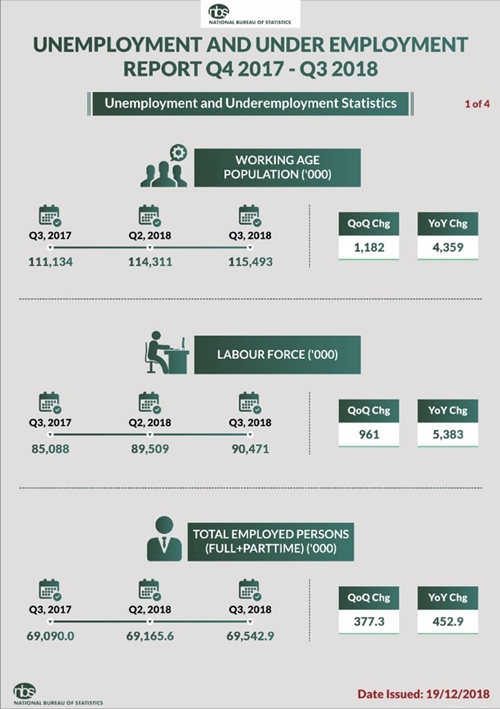“The total number of people in part-time employment (or underemployment) decreased from 13.20 million in Q3 2015 to 11.19 million in Q3 2016 but increased to 18.02 million in Q3 2017 and to 18.21 million in Q3 2018.
“The total number of people classified as unemployed, which means they did nothing at all or worked too few hours (under 20 hours a week) to be classified as employed increased from 17.6 million in Q4 2017 to 20.9 million in Q3 2018.”
Of the 20.9 million people who were unemployed, the report said 8.77 million of them were first-time job seekers, 0.93 million people were unemployed because they lost their jobs and 11.1 people were working for less than 20 hours a week.
Report link @ https://t.co/3VyJ0ShYjS Working age population up from 111.1m in Q3 2017 to 115.4m in Q3 2018. Labor force up from 85.08m in Q3 2017 to 90.47m in Q3 2018. Total Employed persons(Full+Partime)up from 69.09m in Q3 2017 to 69.54m in Q3 2018 pic.twitter.com/OxCTFWJMZS
— Dr Yemi Kale (@sgyemikale) December 19, 2018
Q4 2017-Q3 2018 Labor force report-Vol 1:Unemployment& Underemployment published. Report link @ https://t.co/3VyJ0ShYjS. Trends in persons employed full time and Part-time/underemployed pic.twitter.com/wZGdksDHAO
— Dr Yemi Kale (@sgyemikale) December 19, 2018
Q4 2017-Q3 2018 Labor force report-Vol 1:Unemployment& Underemployment published. Report link @ https://t.co/3VyJ0ShYjS. Trends in unemployment and Partime employment/ underemployment pic.twitter.com/ANqsAnlwuW
— Dr Yemi Kale (@sgyemikale) December 19, 2018
Q4 2017-Q3 2018 Labor force report-Vol 1:Unemployment& Underemployment published. Report link @ https://t.co/3VyJ0ShYjS. Trends in working age population, labor force, net total employed of which full time employment and Partime employment/underemployment and unemployed persons pic.twitter.com/Um8hZHnLDn
— Dr Yemi Kale (@sgyemikale) December 19, 2018




















